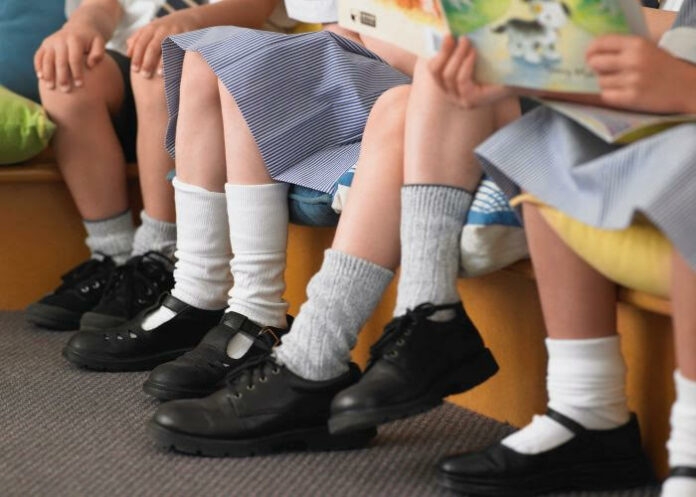South African children who usually go barefoot risk developing clawed and retracted toes, heel spurs and foot arthritis because school shoes sold here are mostly unsuitable, say Stellenbosch University researchers.
In their study, they found that school shoes sold in this country are not ideal for habitually barefoot children because they are too short, narrow or long for their broad feet, reports TimesLIVE.
Their findings, published in BMC Paediatrics, involved almost 700 children, and showed that some 60% wore shoes that were the incorrect length, increasing their risk of developing foot abnormalities.
Other problems linked to badly-fitting shoes include hallus valgus, a progressive foot deformity that affects joints and leads to significant functional disability and foot pain. These problems, said the study team, could lead to changes in the biomechanical alignment of the body, negatively affect walking, and cause pain and other musculoskeletal conditions such as knee osteoarthritis and lower back pain.
In their study, Marise Breet and Ranel Venter, from the Department of Sport Science at Stellenbosch University, set out to determine if the length and width dimensions of prescribed school shoes matched the foot dimensions of habitually barefoot children aged six to 16 in rural and urban SA schools. A total of 77 school shoes of different brands and styles available were measured.
Children who are usually barefoot often have wider feet compared with those who wear shoes regularly.
Breet and Venter measured the feet of 698 children (431 girls and 267 boys) and also measured the length and width of different brands of school shoes. The maximum heel to toe length and foot width, with an added 10mm toe and width fit allowance per participant, were compared to the corresponding school shoe length and width.
“Our results show that comparing the shoe length and maximum heel-toe length of participants, as well as taking 10mm toe allowance into account, 59% of children wore shoes that were not the correct length. And when it came to shoe width and the added 10mm of width fit allowance, 98% of the shoes worn by the children were too narrow for their feet.”
They said given the width dimensions of the shoes in their study, many children in SA would not have the option of a school shoe with a wider forefoot as this is not available.
They said there were several reasons for the prevalence of ill-fitting shoes. One was that shoe manufacturing is predominantly influenced by fashion trends rather than orthopaedic and biomechanical research. “Shoe manufacturers don’t always have the right data to design a standard shape from available measurements and consequently focus on shoe length as a basic measurement without considering the other dimensions.”
They said that often, too much or too little space is left for the toes inside the shoe to ensure a correct shoe fit.
“The recommended toe allowance of 10mm should be considered in addition to the heel-toe length of the child to guarantee the correct fit for shoe length. Our shoe manufacturers use a shoe design based on the British system, using foot length as the basic measurement. In this system, each increase in foot length will correspond with a standardised increase in foot girth, based on European data.”
They recommend that shoe manufacturing companies consider the shoe width of school shoes for habitually barefoot children and adolescents to avoid the long-term negative effects of ill-fitting shoes.
Study details
Are habitually barefoot children compelled to wear ill-fitting school shoes? A cross-sectional study
Marise Carina Breet & Ranel Venter
Published in BMC Pediatrics on 8 April 2022
Abstract
Background
Research shows that ill-fitting shoes can negatively impact the development of the paediatric foot, in a very direct manner. The primary aim of the study was to determine if the dimensions of available prescribed school shoes fit the foot dimensions of habitually barefoot South African children and adolescents.
Methods
A cross-sectional observational study was conducted where static standing foot measurements of children and adolescents from urban and rural schools were obtained with a mobile caliper. The maximum heel-toe-length and foot width with an added 10mm toe- and width fit allowance to each participant, were compared to the corresponding school shoe length and shoe width available in retail. A mixed model ANOVA was used to compare foot dimensions between gender, age and size.
Results
Six hundred and ninety-eight school children (N = 698) (431 girls; 267 boys; average age 10.86 years, SD = 2.55) were participants. A total of seventy-seven (N = 77) black coloured prescribed school shoes currently available in retail ranging from different styles and brands were measured. Results show that, comparing the shoe length and maximum heel-toe-length of participants, as well as taking 10mm toe allowance into account, fifty-nine percent (59%) of children wore shoes that were not the correct length. With regards to the shoe width and the added 10mm of width fit allowance, ninety-eight percent (98%) of the shoes worn by participants were too narrow for their feet.
Conclusions
Results confirmed that school shoes currently available in retail are not suited for the habitually barefoot population studied. It is recommended that the shoe manufacturing industry should consider the shoe width of school shoes for children and adolescents in habitually barefoot populations to avoid the long-term negative effect of ill-fitting shoes on the paediatric foot.
See more from MedicalBrief archives:
Barefoot SA children have better balance but may suffer later
Plantar fasciitis and overuse injuries may link to toe spring in shoes — Harvard
Military-issue footwear causing musculoskeletal injuries

